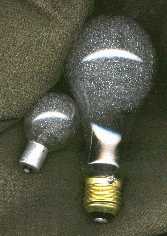Camera Shutters
Focal Plane Shutters
In the picture below the shutter was a slit in a moving curtain (like a window shade) just in front of the film plane. As the slit moved it exposed the film behind it. If the subject was moving during the exposure, you might well get this kind of distortion. In this case the slit moved from the bottom of the image to the top of the image (note: in the camera the image was upside down and reversed so that physically the shutter moved from top of camera to bottom of camera).
Even though Lartigue panned the camera with the car (evidenced by the people slanted toward the left) the car still moved faster so that the wheels are obliqued as first the bottom gets exposed and as the slit moves upward the top (now farther to the right) gets exposed. So the car, and its round wheels look slanted to the right.
It so happens to be just the right distortion for this race car picture from 1913 but other than novelty use would pose real problems when trying to show dancers in motion (see the semi-simulation below)
Very famous picture by Jacques-Henri Charles-Auguste Lartigue:
"Focal Plane Shutter Distortion" with the Rène Croquet's #6 Theophile Schneider racer during the XIII Grand Prix de l'A.C.F. July 12, 1913 at Amiens, France. Because of the effect of moving the exposure-slit from image-bottom to image-top as the car moved from left to right in the frame, the image obliques, making the car look as if it were leaning looking speedy and powerful. (And for the time, it certainly was.)This picture and others inspired by it found their way into Speed Graphic manuals as graphic effects you could perform with your Speed Graphic camera.
Here is a simulation of a dancer (Peter Kalivas in a Kacico workshop) being shot with a Speed Graphic focal plane shutter. In actual fact, he was shot with a focal plane shutter, just in a Digital SLR with a very fast focal plane shutter. We took that photo and modified it. It really isn't the same, but it gives you a visual idea.
 |
|
| Normal shot - our starting point | |
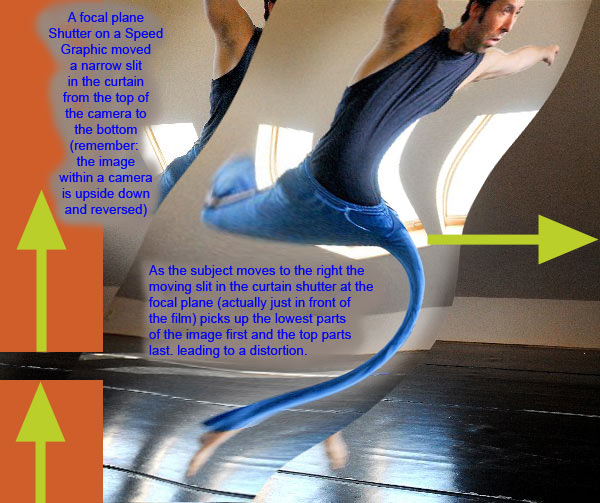 |
|
| Simulated focal-plane shutter skew using Photoshop's "Liquid" filter. As you can imagine, an actual Speed Graphic shooting this would have a somewhat different look but this gives us a visual idea of how dancers might be skewed. | |
 |
|
| Here is the skewed/Liquid version without the text and curtain illustration - just because I like it anyway. | |
Graphic originally tried to make a two-section focal plane shutter but it proved too problematic and so they turned out a long curtain, just like a window shade, with 6 metal-edged various slits in the curtain. The narrowest slit was used for the shortest exposure times. The largest slit was as wide as the film and was used for bulb and time exposures. The original Speed Graphics had
Focal Plane shutters operate today with two sections and cover the entire image area much faster. They are found in just about all 35mm cameras and DSLRs (Digital Single Lens Reflexes).
Between the Lens Shutters - Leaf Shutters
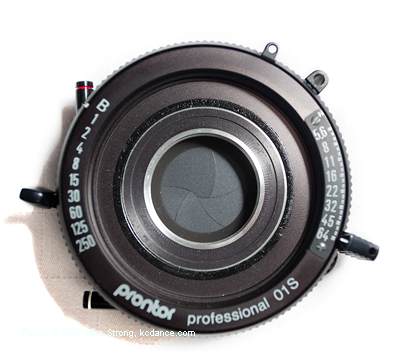
Shutter mechanism includes the iris (aperture). The front elements of the lens screw into the front and the back elements screw into the rear side.
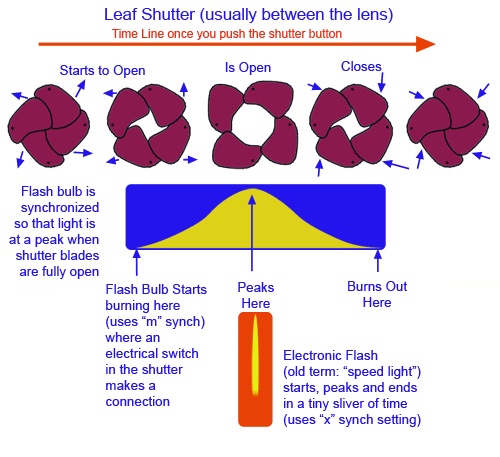 |
| Note: "FP" synch flash bulbs (for focal plane shutters - see above) started their burn earlier and had a sustained, constant output for a long time before burning out (rather than peaking as in the illustration above). That was so that they could provide light for the entire time that the slit in the focal plane was traveling across the image plane. |
Most lens were made with a space in the middle, not only for the diaphram (iris) but also for a mechanical shutter. Actually they were made in two parts, glass for the front elements and glass for the rear elements. Each section screwed into opposite sides of the shutter assembly. A shutter opening at this position - between the front elements and the rear elements of the lens, affected the entire picture at once. Generally the upper limit to a shutter speed for this type of lens was a 400th or a 500th of a second. Later the Super Speed Graphic had a 1/1000th second leaf shutter lens.
Normally these shutters were in the between-the-lens position but they could also be in front of or behind the lens. Some of the earliest shutters were made to slip on to the front of a lens and be activated by air pressure from a rubber bulb. These, in essence, were simply hinged lens covers.
The early flash bulbs used the same base (and looked like) ordinary household light bulbs. The metal "wool" in the bulbs is either magnesium or aluminum filiament which burns very hot and bright very briefly and is then thrown away. Sources of Bulbs: General Information:
|
Flash bulbs were invented in 1928 by the Philips company. The flash tube followed by a few years. In terms of the absolute amount of light they are still the most powerful lights for photography but only used now in specialty applications. |
 A flash tube. Just one of many variaties. This throws out a lot of light and is re-used for thousands of times. |
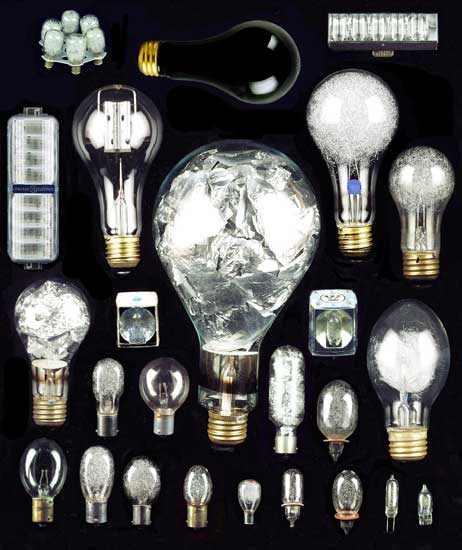
Flash bulbs. Almost none are still available, except as collector's items.


